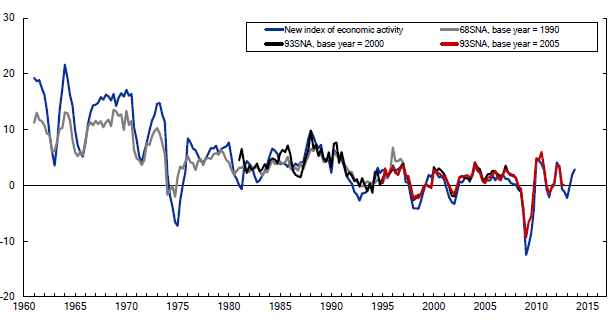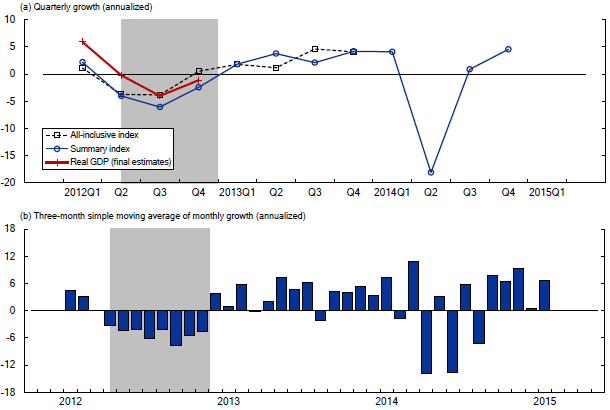A newly developed index designed to measure the overall economic activity shows that the Japanese economy took an upturn in July 2014 and has been on a steady improvement, with its performance in the recent months exceeding the level prior to the consumption tax rate increase. This is consistent with the government's recent upgrading of its overall economic assessment.
New monthly index of economic activity
In an attempt to quantitatively evaluate the real performance of the economy, various economic indexes are constructed and published monthly by the government and private-sector research institutes. Among the most widely used government indexes are the indexes of business conditions (more specifically, the coincident index) published by the Cabinet Office and the index of all industry activity published by the Ministry of Economy, Trade and Industry (METI).
The indexes of business conditions are meant to measure the magnitude and pace of business cycle fluctuations and are calculated as the weighted average of changes in key indicators that are selected from various sectors of the economy and perceived to be sensitive to business cycle fluctuations. For the calculation of the coincident index, a total of 11 economic indicators--including those of industrial production, non-scheduled hours worked, wholesale trade sales (in nominal terms), and retail trade sales (in nominal terms)--are used. However, many of the indicators measuring the performance of service industries, which together accounts for 70% of the Japanese economy (in terms of value added), are left out. Because of this, it has been pointed out that the coincident index is inadequate as a measure of the magnitude of business cycle fluctuations.
Meanwhile, the index of all industry activity is calculated as an average of the three indices of the construction, mining and manufacturing, and service (including government services) industries weighted based on the amount of value added in the base year (updated every five years). As opposed to the coincident index, most industries are covered in this index. However, the index of all industry activity has a shortcoming in that it lacks long-term data consistency, which is attributable chiefly to data inconsistencies in the indices of service industries. Depending on the industry, the source data used for index calculation is subject to change when the base year is updated. For instance, when the base year was changed from 1990 to 1995, source data selected for 31 industries were partly replaced. Thus, it is no exaggeration to say that the index of all industry activity with 1995 as the base year and the index of all industry activity with 1990 as the base year are essentially two different indexes.
Changes in the selection of data have been made as needed for the purpose of obtaining a more accurate picture of activity in each industry. To be sure, there is nothing wrong with statistics officials making such changes--or, I should say, that they are just doing what they are supposed to be doing--as improving the precision of indexes is part of their tasks. Unfortunately, however, due to these circumstances, only few industry-specific indexes have been constructed consistently, in terms of the method and source data, over a long period.
Meanwhile, empirical studies based on recent monthly data are beginning to show a tendency to use the index of all industry activity as a yardstick to measure real economic activity. However, the utility of the index in empirical studies is extremely limited at the moment due to the lack of consistent time series data that are readily available and can cover a sufficiently long period.
In an attempt to fill the gap between needs and availability, I created a new monthly index designed to capture a comprehensive picture of economic activity for the period from 1960 to present (Note 1). The methodology used to construct this index basically follows the one applied by METI in constructing the index of all industry activity. At the same time, however, extra care and diligence have been applied to address the aforementioned shortcomings of the indices of service industries.
Specifically, I have taken the following steps. First, I considered the source data currently adopted by METI in calculating a certain industry-specific index based on the value in 2005, the current base year. If such data can be obtained retrospectively for all of the years prior to 2005, I would use the data as source data for calculating the new index. However, this may be difficult to do so. Then, I would turn to the source data used by METI for the index based on the value in the previous base year to examine whether the data are available for the entire period, i.e., from 1960 to present. If they are, I would use them as the source data for the new index. If not, I would repeat the same process with the data used by METI for the index based on the base year before the previous one. By taking this approach, I have selected the source data for each industry-specific index.
Data selected for the new index are publicly available--those published by the government or private-sector organizations on the results of production activity in each industry such as production volume, sales volume, and sales amount. Industries for which such data are not available have been excluded from the coverage of the index. As a result, the coverage of service-sector industries included in the new index is limited to approximately 80% (in terms of the amount of value added) of those covered in METI's index of tertiary industry activity, a component of the index of all industry activity, with 2005 as the base year. Among those excluded from the new index are financial services, government services, and other public services.
New index as a leading indicator of real GDP
The new index has some desirable characteristics. Figure 1 shows the changes in the growth rates of the new index and real gross domestic product (GDP), both on a year-on-year basis, over the period 1960-2013. Quarterly real GDP data used here are final estimates reported in the Annual Report on National Accounts, and the latest available data are those for the fourth quarter of 2012. We can see that the new index has followed a similar trajectory to that of real GDP.

[Click to enlarge]
If the two indicators are assumed to correspond with each other, the correlation coefficient between the two variables for the same period of time should have its highest value. In order to confirm this, Table 1 shows the correlation coefficient between the growth rate of the new index and that of real GDP computed at different time lags. When we look at the period for which data based on the 1968 United Nations System of National Accounts (68SNA) are used, the correlation coefficient between the growth rate of the index for period (t) and that of real GDP for the same period (k=0) is the highest at 0.93. Likewise, for those periods for which 93SNA-based data are used, the correlation coefficient between the two variables has its maximum value when the time lag is zero.
| SNA (base year) | Period covered | k | ||||||||
|---|---|---|---|---|---|---|---|---|---|---|
| -4 | -3 | -2 | -1 | 0 | 1 | 2 | 3 | 4 | ||
| 68SNA (1990) | 1961Q1-1997Q4 | 0.59 | 0.71 | 0.83 | 0.90 | 0.93 | 0.84 | 0.73 | 0.61 | 0.50 |
| 93SNA (2000) | 1981Q1-2008Q4 | 0.34 | 0.48 | 0.62 | 0.73 | 0.84 | 0.76 | 0.70 | 0.65 | 0.55 |
| 93SNA (2005) | 1995Q1-2012Q4 | -0.16 | 0.13 | 0.44 | 0.78 | 0.94 | 0.73 | 0.41 | 0.07 | -0.20 |
The new index of economic activity also shows correlations with some other indicators of economic recession. For instance, periods for which the growth rate of the index (i.e., deviation from the trend) has been continuously negative correspond with the downswing phases as defined by the Cabinet Office's Economic and Social Research Institute (ESRI). And they are generally in agreement with the periods in which the diffusion index of business sentiment in the Bank of Japan (BOJ)'s Tankan, or short-term business sentiment survey, was on a downward trend. These findings suggest that the new index of economic activity is useful as a monthly indicator of real economic activity.
Latest movement in the new index
Plotted in the upper chart in Figure 2 are the seasonally-adjusted annualized quarterly growth rates of the new index and real GDP from 2012 onward. Here, the quarterly growth rate of the new index is calculated as a change in the three-month average of monthly index values. The dotted line represents the new index of economic activity as explained above (hereinafter referred to as the "all-inclusive index" for distinction). The blue line denotes the index of economic activity excluding certain industries for which the latest data are not available (hereinafter referred to as the "summary index"). The coverage of industries included in the summary index is roughly 70% of that of the all-inclusive index in terms of the amount of value added. Meanwhile, the red line denotes real GDP (final estimates) (Note 2). The gray area indicates the period preliminarily defined as a downswing phase by the ESRI.

[Click to enlarge]
We can see that both of all-inclusive and summary indices followed a trajectory similar to that of the real GDP growth, sinking in the negative region during the downswing phase in 2012 with the only exception being the fourth quarter in which the all-inclusive index was slightly above zero.
The lower chart shows the three-month simple moving average of the annualized monthly growth of the summary index. When we look at the period from 2014, the growth rate dropped significantly in April and June, which is considered to be attributable to pullbacks from the last-minute demand prior to the consumption tax rate hike in April 2014. The growth rate of the summary index turned positive in July 2014 and generally has maintained a level slightly above the level observed before the tax hike in the subsequent months. Although the growth rate was sharply down in August 2014, this is considered to be a reflection of a temporary decline in economic activity caused by unusually bad weather such as record-breaking heavy rain and lack of sunshine. The government recently upgraded its overall economic assessment. The new economic activity index supports the judgment.

